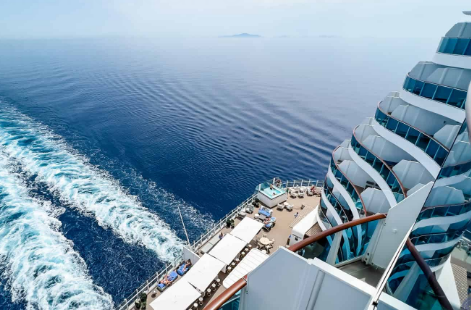What to Expect When Cruising the Mediterranean’s Most Iconic Ports

Cruising through the Mediterranean offers a unique blend of historical wonder, vibrant cultures, and picturesque landscapes. Whether you’re a seasoned traveler or setting sail for the first time, the allure of the region lies not only in its beauty but also in the remarkable diversity of its ports. Each stop tells a different story—ancient ruins, sun-soaked coasts, bustling markets, and culinary traditions that stretch back centuries. Here’s what you can expect when visiting some of the Mediterranean’s most iconic ports and how to make the most of your time ashore.
A World of History in Every Harbor
One of the defining traits of the Mediterranean is its sheer density of historical landmarks. Cities like Rome, Athens, and Dubrovnik are essentially open-air museums. Stepping off the ship in these cities can feel like stepping into a time machine.
In Rome’s port of Civitavecchia, many travelers take the opportunity to journey inland for a day in the Eternal City. While the Vatican, Colosseum, and Roman Forum are high on most must-see lists, don’t overlook wandering side streets to discover less-crowded gems like Trastevere or the Aventine Keyhole.
Athens, accessed via the port of Piraeus, offers another plunge into antiquity. The Acropolis and its museum are rightly famous, but there’s more to modern Athens than ruins. A thriving café culture and eclectic neighborhoods like Plaka provide a balance between past and present.
When docking in Dubrovnik, Croatia—known as the “Pearl of the Adriatic”—expect towering medieval walls, baroque architecture, and jaw-dropping coastal views. For those who enjoy a slightly slower pace, a walk atop the city walls or a cable car ride up Mt. Srđ offers a quieter, panoramic experience.
Vibrant Cultures and Bustling Markets
Mediterranean ports are more than historical sites; they’re windows into daily life in Southern Europe and North Africa. Walking through local markets, browsing artisan shops, and sipping coffee in a sunlit plaza can offer some of the most authentic experiences of your journey.
In Barcelona, you might be greeted by the dazzling colors of La Boqueria Market just off La Rambla. Here, the scent of fresh citrus mingles with that of jamón ibérico and grilled seafood, inviting you to taste your way through Catalonia.
Istanbul, straddling both Europe and Asia, is a port that deserves special attention. The Grand Bazaar and Spice Market offer an explosion of scents and textures, while the Blue Mosque and Hagia Sophia serve as striking reminders of the city’s layered history. While technically bordering the eastern Mediterranean, Istanbul is often included on many Mediterranean cruise itineraries due to its rich historical significance.
At Palermo in Sicily, prepare for a feast of sights, sounds, and tastes. Street food reigns supreme—arancini, panelle, and cannoli are local staples. Palermo’s markets, like Ballarò or Vucciria, feel as though they haven’t changed in generations, providing a glimpse into a more traditional Mediterranean lifestyle.
Shore Excursions and Independent Adventures
While some ports lend themselves well to guided tours—especially those with complex transportation or expansive archaeological sites—others are perfect for independent exploration.
A Mediterranean cruise typically blends a mix of both. For example, in Nice, France, you might enjoy a curated tour that takes you to nearby Monaco or Eze Village. Yet, in Santorini, many travelers choose to explore independently, taking the iconic cable car up to Fira and wandering through the cliffside towns of Oia and Imerovigli.
It’s important to research each port in advance to determine what kind of experience best suits your interests and energy levels. Some cruisers enjoy the flexibility of walking tours or hop-on-hop-off buses, while others prefer private guides to avoid the crowds and customize their time ashore.
Cuisine That Reflects the Region’s Diversity
Food is a central part of the Mediterranean experience, with each region offering its own specialties. You’ll find that even a casual lunch at a seaside taverna or piazza café can be unforgettable.
In Marseille, France, don’t miss the chance to try bouillabaisse, a traditional Provençal fish stew that reflects the region’s maritime culture. Pair it with a glass of chilled rosé for a true taste of southern France.
On the Greek islands like Mykonos or Rhodes, fresh seafood, moussaka, and locally made feta cheese are menu staples. Many visitors also enjoy sampling ouzo or tsipouro, traditional Greek spirits often served with small meze plates.
In Valencia, Spain, home of paella, the dish is more than a meal—it’s a social event. Seek out restaurants where it’s cooked over wood fires in traditional pans, often shared family-style. Cruisers often find that Mediterranean cuisine is not only delicious but also quite healthy, rich in vegetables, olive oil, and fresh ingredients.
Smooth Sailing Between Cultures
One of the advantages of a Mediterranean cruise is how effortlessly you move between vastly different cultures and languages. It’s not uncommon to wake up in a Spanish-speaking country and end the day among Italian speakers. This seamless transition can be exciting, though it also means preparing for slight adjustments in customs and expectations.
Even within the Schengen zone, where passport checks are minimal, differences in tipping etiquette, dining hours, and social norms can vary by country. It’s helpful to carry a translation app or phrasebook, as well as local currency for smaller purchases, even though cards are widely accepted.
Final Thoughts
Cruising the Mediterranean’s most iconic ports is like flipping through the pages of the world’s most beautiful travel magazine—except you’re living it. From the artistic pulse of Barcelona to the archaeological wonders of Athens and the coastal charm of Dubrovnik, each port offers something unique and unforgettable.
Whether your itinerary focuses on the western Mediterranean or dips into the eastern stretch of the region, these ports promise not just impressive photo ops but enriching, immersive experiences. A Mediterranean cruise is more than just a vacation—it’s a cultural journey, one that lets you wake up to a new world each day, without ever packing and unpacking a suitcase.

